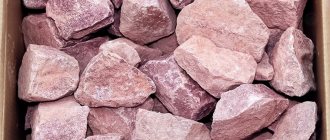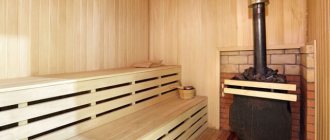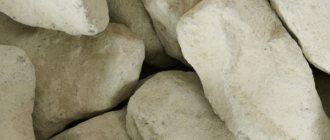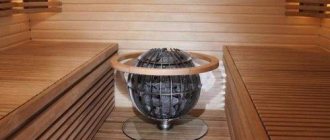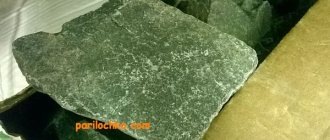Of the fairly extensive list of minerals used in the bath, soapstone is used most often, especially for lining various surfaces. The reason for its popularity is the relatively low price, easy processing and performance characteristics of the stone. Soapstone is a metamorphic rock widely used in bathhouses.
This stone has a thermal spectrum identical to the sun's rays. Therefore, the heat from it is perceived by a person most comfortably, and the steam created by the mineral is felt like a gentle, velvety touch.
5/5 — (1 vote)
Characteristics and properties
Soapstone is a rock complex in structure, consisting of talc (40-50%), magnesite (40-50%) and chlorite (5-8%). The mineral and chemical composition of the stone is variable. The ratios of chlorite and magnesite can vary, dividing the other half. The range is from 40 to 8 percent to 18 to 30%. At the same time, the general properties of the mineral from such different ratios of components practically do not change.
The color of soapstone is gray, depending on the impurities with white, brown, green or yellow tints, and much less often - red or dark cherry. The structure of the stone is opaque. The surface is silky, with a matte shine. Rock hardness is from 1 to 5.5. Density - approximately 2.75.
The mechanical properties of soapstone include softness. This quality allows stone to be processed into tiles with a torn surface and other building materials. Softness contributes to the gradual destruction of the mineral due to crumbling of talc at high temperatures.
Physical properties include:
- thermal conductivity - 3.3 W;
- specific heat capacity 0.98 kJ/(kg × K);
- hardness on the Mohs scale – 2.0–3.0.
Installation recommendations
When laying a soapstone floor, the same method is used as for ceramic products. The underlying layer is cleaned, dust-free and treated with a primer. Direct laying is carried out on a cement-sand mortar.
In this case, the grade of the mixture should be higher than 150. For ease of work and to ensure evenness, it is necessary to install beacons in increments of no more than 2 m. You should clearly know that the width of the joint between the tiles should not exceed 3 mm.
Often, natural stone coatings become dirty and dusty after finishing installation work. To remove contaminants, water is used, supplied from a hose under a pressure of 2…3 atmospheres. To achieve the best effect, it is advisable to combine hose cleaning with manual cleaning using brushes.
Soapstone for cladding is a universal material used for wall, floor and decorative finishing. It has plenty of advantages - temperature and alkali resistance, water resistance and durability, but there are only two disadvantages.
It is not for nothing that this rock began to be used by humans several thousand years ago. This is due to its distinctive strength, which allowed people to use soapstone to make dishes and statues.
Where is the stone mined?
The leader in the production of soapstone chlorite is Finland. Russia takes second place in terms of supply volumes of this breed.
The largest deposit in our country stretches in a mountain range from Medvezhyegorsk to Finland itself. Mining is also carried out in the Shabrovskoye field in the Urals.
The stone is also mined in the following countries:
- Brazil;
- USA;
- India.
What you need to know
To increase the service life of the masonry, it is necessary to care for it. Each element is checked for integrity and cleaned; if chips or damage to the surface are detected, it must be replaced with a new one. If you frequently use essential oils in a steam room, you should periodically remove carbon deposits from the stones. It should also be noted that soapstone for baths can only be purchased at special points of sale, since stones collected independently can release substances harmful to health when heated.
Areas of application
Due to the increased heat capacity and characteristics of the rock, the stone has been used since ancient times for the manufacture of carved products, in construction and in baths. Figures and figurines, vases, and dishes were created from soapstone. Pots and pans are still made from soapstone today.
Such dishes retain heat perfectly, leaving the dish hot for a long time. The earliest stone products found by archaeologists are 4–5 thousand years old.
In construction, stone is used as bricks, tiles, crushed stone, and powder. The materials are used for masonry, cladding walls of residential premises, swimming pools, and heated floors.
The mineral is excellent for masonry and cladding of fireplaces and stoves. Rock powder is added to building mixtures and concrete.
Fireplace mantle
Modern fireplaces are varied in form, although the meaning remains the same as in the Middle Ages: a niche in which a fire burns, and combustion products are removed from the room through a chimney.
The design is very imperfect in terms of fuel efficiency. Therefore, among the attempts to improve it is facing the fireplace with natural stone. Its purpose is to heat the stone, which will give off heat for some time after the fuel supply stops.
Soapstone cladding for a fireplace is one of the best options for prolonging heat output. Only we doubt that centimeter-thick tiles will be able to provide significant heat accumulation.
Stove-Fireplace VESUVIUS PK-01 (220) corner, soapstone. Photo Teplokontakt
In principle, nothing prevents you from calculating how much thermal energy a tile of a given size can accumulate. Here's the formula:
Volume of the tile*density of the stone*desired heating temperature*heat capacity of the stone= number of kilojoules of accumulated energy
But even without calculations it is clear that for tiles 1 cm thick and 5 cm thick, the energy will differ by 5 times , because that is how much more its volume will be. Draw conclusions about the duration of heat transfer in the first and second cases with the same initial temperature difference between the tile and the room.
Features of use in the bath
Soapstone is widely used in baths and saunas because it holds heat well and slowly releases heat due to the hydroxyl group in the composition, as well as the poor heat conductivity of talc:
- Stone stoves are made from the rock or brick and metal stoves are lined with it. This means that there is a steel or cast iron firebox inside, which is covered on the outside with a stone casing. Lining the steel walls with soapstone tiles provides a comfortable level of heat dissipation. As a result, the sauna stove turns out to be quite economical, because the heat does not escape into the chimney with the products of burning wood, and at the same time it is powerful, but not scalding.
- The walls of the baths are sometimes finished with soapstone tiles, smooth or in the form of torn stones, for the aesthetics of the room. In an array, such cladding strongly resembles marble. This finish also has a practical meaning. It is believed that lining the walls and flow with stone in a steam room can effectively warm up and treat radiculitis and inflammation of the back muscles. If soapstone tiles or torn stone are used to decorate the walls of the bathhouse, then the atmosphere in the room becomes light and pleasant to breathe, even at high humidity levels.
- Stone is used as a filler for heaters. When exposed to strong heating and constant watering with boiling water, the material does not burn and does not change size. This means that a pile of hot stones, even after repeated calcination, will not collapse and create a dangerous situation, as often happens with river pebbles or gabbro. According to reviews from experienced bathhouse attendants, soapstone stones make the steam not as hot as when using a quartzite stove backfill.
Rules for preparing stone before placing it in the kiln:
- The stones are washed with a brush in plenty of water. During the procedure, dirt is washed off, uneven, chipped specimens are rejected.
- Then the soapstone is dried and hardened over fire.
- The cooled rock is beaten with a hammer to test its strength.
- The samples that survived two impacts are placed in the oven. Splintered or cracked rock is not suitable for the heater. Such specimens will quickly crumble.
How to line a stove with soapstone?
There are no special features of laying stones or differences from tiling stoves. All work is carried out according to a certain scheme:
Stages of work on lining the furnace with soapstone
- We clean the surfaces of the oven from old mortar or dirt;
- Degrease metal parts with solvent;
- Preparing the mortar for masonry. To do this, it is recommended to buy a special composition from Finland. It is made from crushed stone and liquid glass. Such a solution will reliably hold the cladding for a long time. We attach perforated corners to the corners and bottom of the oven walls to protect the tiles and prevent them from slipping when laying;
- In the firebox, be sure to lay the stone only horizontally, such tiles will warm up faster. The facing parts are unraveled across the fiber - this ensures rapid heating and gradual heat release;
- We fill all voids with mortar and constantly check the correct placement of individual stone tiles;
- We install brackets or crosses between the stones for an even and uniform seam. After the work is completed and the solution has hardened, we remove the crosses and rub all the seams with the prepared mixture.
The work is not difficult, but requires a careful and responsible attitude. But by doing the work yourself, you have the opportunity to save tens of thousands of rubles.
Stone selection criteria
It is difficult to confuse soapstone with other stones because it is soapy or greasy to the touch. At the same time, the quality of the breed may vary.
To choose a stone, it is important to pay attention to the following points:
Crushed or tumbled. The difference in shape determines two things. Due to the uneven surface, crushed stones produce more steam, but they break down faster. The water will evaporate worse from the tumbled ones, since it will constantly strive to flow lower. But such stones look beautiful and last longer.
Look closely at the surface of the stone. If there are specks of gray or brass color with a metallic sheen on it, then this is the cause and guarantee of a bad smell. These are sulfides. When the stone heats up, they will evaporate into the air and become a stinging sensation in your eyes and a sore throat. A small number of inclusions is acceptable - they will disappear during the first fires, but when there are a lot of them, it is better to immediately abandon such a stone.
Pay attention to the uniform color of the mineral texture on the fracture or treated surface. The stone should not contain any foreign inclusions of black, yellow or green color. As a rule, these are salts of heavy metals, many of which are toxic or even poisonous.
If you select soapstone tiles, in addition to uniform color, you need to pay attention to the absence of cracks and micro-chips. Their presence indicates that the stone was processed in violation of the cutting technology or temperature conditions. Such lining in a bathhouse will not last long.
Important! Visiting a steam room with a heater charged with soapstone is contraindicated for people with talc intolerance.
Impact on the body
Reviews of soapstone for baths are mostly positive, many note its medicinal properties. In particular, it is common during hot massage; under its influence, the skin is rejuvenated and cleared of inflammation. In the assortment of stores you can find stone heating pads made from Karelian mineral; according to buyers, they are convenient for treatment at home. Also, soapstone for baths reduces blood pressure, improves immunity, has a beneficial effect on the throat and lungs, and accelerates the passage of colds.
FAQ
The store offers ground and crushed soapstone. Which one is better?
The crushed one produces more steam, the polished one generates less dust and lasts longer. So the choice is yours.
Experts do not advise taking soapstone from the Urals. Why?
In the Urals, the stone is not as clean and dense as in Karelia.
If soapstone is so soft, it means it is easier to mine than other stones. So why is it so expensive?
Because it is quite rare when it comes to high-quality specimens.
Soapstone is covered with dust, which remains on the hands. If it is so dusty, how can you use it in a steam room? Will it still fly in the air?
After the first steam room, the talc wears off and the stone lasts a long time.
There are bath stones: rodingite, porphyrite, dunite, soapstone. In what order should they be placed in the heater?
Soapstone should be laid first, since it gives off heat longer than other stones. Heat-accumulating linings for sauna stoves and fireplaces are also made from it. Soapstone is healthier than all the other stones you have.
Operating rules
In Finland, such heating devices are the basis for obtaining heat in a country house. The front side opens into the living room or dining room. The rear part with the combustion chamber, hob and oven are installed in the kitchen.
We heat the stove as needed. Units equipped with an exhaust gas afterburning system allow you to add firewood no more than several times a day. Otherwise, the operation of such devices is similar to conventional heaters.
But don’t get carried away with firewood; the characteristics of the materials allow you to save fuel. If you constantly put firewood in the rooms, the heat will be unbearable. After lining, be sure to dry the stove by burning small amounts of fuel in the firebox.


